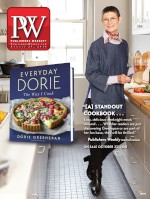It used to be that fantastic (and often abstract) ideas that gave print manufacturers indigestion and nightmares would originate from the publisher or designer. These days, those ideas are just as likely to come from the print manufacturers themselves in a bid to add value to their services, highlight the capabilities within their product development and paper engineering divisions, and help their clients to further differentiate their offerings on the shelves.
Advances in color-separation, printing, binding, and postpress processes have made many seemingly impossible project ideas deliverable not only on time but also at high quality and within budget. The following four projects—randomly chosen to highlight different print product categories—exemplify the capabilities and can-do spirit of Hong Kong and China print manufacturers.
A Sticky Issue
Stickers of all kinds, including puffy, holographic, and textured, are trendy right now, says Howard Musk, president and CEO of Imago. “We recently produced the Pipsticks gift line of notebooks, journals, and planners packed with different types of stickers for Workman,” he notes. “Bringing the stickers and products together took a lot of planning, from the unique matchbook-style binding for the notepads to the double elastics for the journals, which function as bookmarks and closures. Then there were laminated tabs, foil bags, post-its, and postcards as well as intricate die cutting for some of the stickers.”
A Weighty Topic
Covering more than 460 pages and housed inside a gift box, the large-format Al-Masjid Al-Aqsa (35 cm x 46 cm) weighs 11 kg. “While the 4,000-copy print run is not a big order, the printing process was quite complex,” says production director Chan Hon Kwong of Jade Productions. “In addition to CMYK, the book designer used metallic PMS in different chapters, with several signatures in seven-color printing, which was CMYK plus three metallic PMS.” Then there was the question of how to pack the heavy title. “At the end, we tailor-made a carrying carton with interlocking construction—with no packing tape required—so that it is easy for the buyer to carry the book home after purchase.”
Redefining Complexity
Beauty and the Beast, praised as “an engineering wonder” by the Printing Industries of America, won three Benny awards at the 2017 Premier Print Awards and later swept the top prizes at both the Gold Ink and China Print Awards. “Our product engineering team collaborated closely with our client, Ronshin Group, right from the start and was inspired by the traditional Chinese lantern in creating this 360-degree pop-up,” says Andy Lau, general manager for sales at Leo Paper. “Several Chinese cultural elements—intricate die cutting and lighting effects, for instance—were added to this beloved Disney classic. The result was a harmonious East/West blend of product that is targeted at the domestic Chinese market. Extensive application of LeoTouch secondary processes further enhanced the value of this book and increased its appeal for children and parents alike.”
When Every Minute Counts
Having a production facility with complete in-house capabilities covering CtP, printing, binding, and transportation is crucial for ultrashort projects. “For daily show newsletters, for instance, the files usually arrive in the late afternoon,” says Percy Leung of the overseas sales team of Magnum Offset. “The printing is done throughout the night, with delivery to the exhibition halls finished by seven the following morning.” Leung says that such saddle-stitched dailies tend to be between eight and 20 pages in length with print runs of 15,000 to 20,000 copies in bilingual language editions. “Many clients had their ultrashort projects rejected by printers who do not operate a night shift, who have workers uninterested in overtime, or who do not have complete in-house production facilities,” he notes. “For us, such projects provide opportunities to develop a niche market—and clients are more than happy to pay extra for overnight delivery—while providing a much-needed service to exhibitors and exhibition organizers.”



 Volume 265
Issue 35
08/27/2018
Volume 265
Issue 35
08/27/2018





